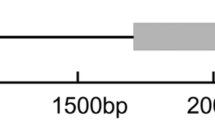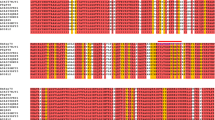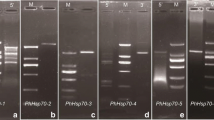Abstract
Under stress conditions, the mitochondrial respiratory chain generates reactive oxygen species that cause oxidative damage to lipids, proteins and nucleic acids. Mitochondrial chaperones are essential for repairing denatured proteins in plants confronted with diverse stresses. However, their functions have not been well characterized in lower plants such as bryophytes. Here, we cloned a heat-shock 70 protein gene (designated PnHSP70) from the Antarctic moss Pohlia nutans and investigated its transcription levels under stress conditions. The PnHSP70 cDNA encoded a polypeptide of 678 amino acids with an ATPase domain, a substrate peptide-binding domain and a C-terminal domain. Sequence alignment and phylogenetic analysis showed that PnHSP70 was homologous to other known mitochondrial HSP70 proteins. In addition, subcellular localization analysis in which the transient expression of PnHSP70-green fluorescent protein was observed in Arabidopsis thaliana mesophyll protoplasts revealed that PnHSP70 was targeted to mitochondria. Real-time PCR analysis showed that low or high temperature, salinity, drought or PEG treatments as well as UV-B radiation could induce up-regulation of PnHSP70 expression levels. The plant hormones abscisic acid and jasmonic acid also up-regulated the expression levels of PnHSP70. Together, our results revealed that PnHSP70, as a mitochondrial chaperone, might play an important role in the adaptation of the Antarctic moss P. nutans to the polar environment.









Similar content being viewed by others
References
Alder NN, Shen Y, Brodsky JL, Hendershot LM, Johnson AE (2005) The molecular mechanisms underlying BiP-mediated gating of the Sec61 translocon of the endoplasmic reticulum. J Cell Biol 168:389–399
Alvim FC, Carolino SM, Cascardo JC, Nunes CC, Martinez CA, Otoni WC, Fontes EP (2001) Enhanced accumulation of BiP in transgenic plants confers tolerance to water stress. Plant Physiol 126:1042–1054
Berli FJ, Fanzone M, Piccoli P, Bottini R (2011) Solar UV-B and ABA are involved in phenol metabolism of Vitis vinifera L. increasing biosynthesis of berry skin polyphenols. J Agric Food Chem 59:4874–4884
Bhyan SB, Minami A, Kaneko Y, Suzuki S, Arakawa K, Sakata Y, Takezawa D (2012) Cold acclimation in the moss Physcomitrella patens involves abscisic acid-dependent signaling. J Plant Physiol 169:137–145
Bramley-Alves J, King DH, Robinson RA, Miller RE (2014) Dominating the Antarctic environment: bryophytes in a time of change. In: Hanson DT, Rice SK (eds) Photosynthesis in bryophytes and early land plants. Springer, Dordrecht, pp 309–324
Chinnusamy V, Zhu JH, Zhu JK (2007) Cold stress regulation of gene expression in plants. Trends Plant Sci 12:444–451
Clarke LJ, Robinson SA (2008) Cell wall-bound ultraviolet-screening compounds explain the high ultraviolet tolerance of the Antarctic moss, Ceratodon purpureus. New Phytol 179:776–783
Convey P, Smith RIL (2006) Responses of terrestrial Antarctic ecosystems to climate change. Plant Ecol 182:1–10
Convey P, Stevens MI (2007) Antarctic Biodiversity. Science 317:1877–1878
De Los RiosP, Ben-Zvi A, Slutsky O, Azem A, Goloubinoff P (2006) Hsp70 chaperones accelerate protein translocation and the unfolding of stable protein aggregates by entropic pulling. Proc Natl Acad Sci USA 103:6166–6171
de Ollas C, Hernando B, Arbona V, Gómez-Cadenas A (2013) Jasmonic acid transient accumulation is needed for abscisic acid increase in citrus roots under drought stress conditions. Physiol Plant 147:296–306
Dinamarca J, Sandoval-Alvarez A, Gidekel M, Gutiérrez-Morag A (2013) Differentially expressed genes induced by cold and UV-B in Deschampsia antarctica Desv. Polar Biol 36:409–418
Dong Y, Dong S, Meng X (2008) Effects of thermal and osmotic stress on growth, osmoregulation and Hsp70 in sea cucumber (Apostichopus japonicus Selenka). Aquaculture 276:179–186
Fu W, Yao J, Wang X, Liu F, Fu G, Duan D (2009) Molecular cloning and expression analysis of a cytosolic Hsp70 gene from Laminaria japonica (Laminariaceae, Phaeophyta). Mar Biotechnol 11:738–747
Germot A, Philippe H, Le Guyader H (1996) Presence of a mitochondrial-type 70-kDa heat shock protein in Trichomonas vaginalis suggests a very early mitochondrial endosymbiosis in eukaryotes. Proc Natl Acad Sci USA 93:14614–14617
Gill SS, Tuteja N (2010) Reactive oxygen species and antioxidant machinery in abiotic stress tolerance in crop plants. Plant Physiol Biochem 48(12):909–930
Gornall JL, Jónsdóttir IS, Woodin SJ, der Wal RV (2007) Arctic mosses govern below-ground environment and ecosystem processes. Oecologia 153:931–941
Horst M, Oppliger W, Rospert S, Schonfeld HJ, Schatz G, Azem A (1997) Sequential action of two hsp70 complexes during protein import into mitochondria. EMBO J 16:1842–1849
Huovinen P, Gómez I (2013) Photosynthetic characteristics and UV stress tolerance of Antarctic seaweeds along the depth gradient. Polar Biol 36:1319–1332
Kato K, Arikawa T, Imura S, Kanda H (2013) Molecular identification and phylogeny of an aquatic moss species in Antarctic lakes. Polar Biol 36:1557–1568
Kumar S, Nei M, Dudley J, Tamura K (2008) MEGA: a biologist-centric software for evolutionary analysis of DNA and protein sequences. Brief Bioinform 9:299–306
Liu S, Zhang P, Cong B, Liu C, Lin X, Shen J, Huang X (2010) Molecular cloning and expression analysis of a cytosolic Hsp70 gene from Antarctic ice algae Chlamydomonas sp. ICE-L. Extremophiles 14:329–337
Liu S, Wang N, Zhang P, Cong B, Lin X, Wang S, Xia G, Huang X (2013) Next-generation sequencing-based transcriptome profiling analysis of Pohlia nutans reveals insight into the stress-relevant genes in Antarctic moss. Extremophiles 17:391–403
Livak KJ, Schmittgen TD (2001) Analysis of relative gene expression data using real-time quantitative PCR and the 2−ΔΔCt method. Methods 25:402–408
Lovelock CE, Jackson AE, Melick DR, Seppelt RD (1995) Reversible photoinhibition in Antarctic moss during freezing and thawing. Plant Physiol 109:955–961
Madden LA, Sandström ME, Lovell RJ, McNaughton L (2008) Inducible heat shock protein 70 and its role in preconditioning and exercise. Amino Acids 34:511–516
Mayer MP, Bukau B (2005) Hsp70 chaperones: cellular functions and molecular mechanism. Cell Mol Life Sci 62:670–684
Montero-Barrientos M, Hermosa R, Cardoza RE, Gutiérrez S, Nicolás C, Monte E (2010) Transgenic expression of the Trichoderma harzianum hsp70 gene increases Arabidopsis resistance to heat and other abiotic stresses. J Plant Physiol 167:659–665
Morgan-Kiss RM, Priscu JC, Pocock T, Gudynaite-Savitch L, Huner NP (2006) Adaptation and acclimation of photosynthetic microorganisms to permanently cold environments. Microbiol Mol Biol Rev 70:222–252
Newsham KK (2010) The biology and ecology of the liverwort Cephaloziella varians in Antarctica. Antarct Sci 22:131–143
Pearce DA (2008) Climate change and the microbiology of the Antarctic Peninsula region. Sci Prog 91:203–217
Raghavendra AS, Gonugunta VK, Christmann A, Grill E (2010) ABA perception and signalling. Trends Plant Sci 15:395–401
Rautenberger R, Wiencke C, Bischof K (2013) Acclimation to UV radiation and antioxidative defence in the endemic Antarctic brown macroalga Desmarestia anceps along a depth gradient. Polar Biol 36:1779–1789
Reddy PS, Mallikarjuna G, Kaul T, Chakradhar T, Mishra RN, Sopory SK, Reddy MK (2010) Molecular cloning and characterization of gene encoding for cytoplasmic Hsc70 from Pennisetum glaucum may play a protective role against abiotic stresses. Mol Genet Genomics 283:243–254
Renner T, Waters ER (2007) Comparative genomic analysis of the Hsp70s from five diverse photosynthetic eukaryotes. Cell Stress Chaperon 12:172–185
Reyes M, Corcuera LJ, Cardemil L (2003) Accumulation of HSP70 in Deschampsia antarctica Desv. leaves under thermal stress. Antarct Sci 15:345–352
Rhoads DM, Umbach AL, Subbaiah CC, Siedow JN (2006) Mitochondrial reactive oxygen species. Contribution to oxidative stress and interorganellar signaling. Plant Physiol 141:357–366
Shi LX, Theg SM (2010) A stromal heat shock protein 70 system functions in protein import into chloroplasts in the moss Physcomitrella patens. Plant Cell 22:205–220
Shim EH, Kim JI, Bang ES, Heo JS, Lee JS, Kim EY, Lee JE, Park WY, Kim SH, Kim HS, Smithies O, Jang JJ, Jin DI, Seo JS (2002) Targeted disruption of hsp70.1 sensitizes to osmotic stress. EMBO Rep 3:857–861
Singh J, Dubey AK, Singh RP (2011) Antarctic terrestrial ecosystem and role of pigments in enhanced UV-B radiations. Rev Environ Sci Biotechnol 10:63–77
Skotnicki ML, Ninham JA, Selkirk PM (2000) Genetic diversity, mutagenesis and dispersal of Antarctic mosses-a review of progress with molecular studies. Antarct Sci 12:363–373
Song W, Lin X, Huang X (2012) Characterization and expression analysis of three cold shock protein (CSP) genes under different stress conditions in the Antarctic bacterium Psychrobacter sp. G. Polar Biol 35:1515–1524
Timperio AM, Egidi MG, Zolla L (2008) Proteomics applied on plant abiotic stresses: role of heat shock proteins (HSP). J Proteomics 71:391–411
Vanlerberghe GC (2013) Alternative oxidase: a mitochondrial respiratory pathway to maintain metabolic and signaling homeostasis during abiotic and biotic stress in plants. Int J Mol Sci 14:6805–6847
Victoria FC, Pereira AB, Costa DP (2009) Composition and distribution of moss formations in the ice-free areas adjoining the Arctowski region, Admiralty Bay, King George Island, Antarctica. Iheringia, Série Botânica 64:81–91
Wang S, Zhu X, Yang Y, Yang J, Gu Y, Wei J, Hao R, Boireau P, Cui S (2009) Molecular cloning and characterization of heat shock protein 70 from Trichinella spiralis. Acta Trop 110:46–51
Yoo SD, Cho YH, Sheen J (2007) Arabidopsis mesophyll protoplasts: a versatile cell system for transient gene expression analysis. Nat Protoc 2:1565–1572
Zhang H, Cui P, Lin L, Shen P, Tang B, Huang YP (2009a) Transcriptional analysis of the hsp70 gene in a haloarchaeon Natrinema sp. J7 under heat and cold stress. Extremophiles 13:669–678
Zhang L, Li Y, Xing D, Gao C (2009b) Characterization of mitochondrial dynamics and subcellular localization of ROS reveal that HsfA2 alleviates oxidative damage caused by heat stress in Arabidopsis. J Exp Bot 60:2073–2091
Zhang P, Liu S, Chen K (2013) Characterization and expression analysis of a glutathione reductase gene from Antarctic moss Pohlia nutans. Plant Mol Biol Rep 31:1068–1076
Acknowledgments
We thank Mr. Robbie Lewis for assistance in the manuscript editing. This work was financially supported by the National Natural Science Foundation of China (41206176 and 40906103), Chinese Polar Environment Comprehensive Investigation and Assessment Programmes (CHINARE2012-01-06).
Author information
Authors and Affiliations
Corresponding author
Rights and permissions
About this article
Cite this article
Liu, S., Wang, J., Cong, B. et al. Characterization and expression analysis of a mitochondrial heat-shock protein 70 gene from the Antarctic moss Pohlia nutans . Polar Biol 37, 1145–1155 (2014). https://doi.org/10.1007/s00300-014-1508-8
Received:
Revised:
Accepted:
Published:
Issue Date:
DOI: https://doi.org/10.1007/s00300-014-1508-8




